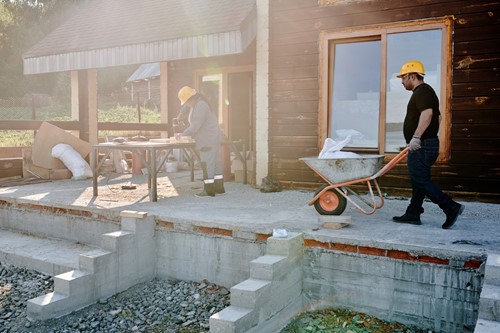
In both existing homes and new construction, there are several common types of foundations for houses. Each has their advantages and disadvantages, including specific maintenance requirements and climate-specific considerations.
Whether you’re building a new home or want to learn more about how to care for your existing home, it’s worth exploring the three major types of foundations used for houses:
Basement foundation
Basement foundations are essentially holes dug beneath the house, matching most or all of the ground-level square footage. Builders use concrete footings around the edge of the basement space as a frame for the foundation, then follow with beams, walls and a concrete slab at the bottom.
Basement foundations can add extra living space to the home, potentially doubling the square footage if finished. Otherwise, unfinished basements serve as valuable storage space and shelter in case of extreme weather.
Concrete slab foundation
Concrete slab foundations are made of a simple, flat layer of concrete situated slightly below the surface of the ground. This is one of the simplest foundation types to install, involving a wire mesh and reinforcing bars within the concrete for extra stability.
Slab foundations are best for warmer regions, as frozen ground can cause cracks and shifts in the concrete. However, in the right conditions, a slab foundation will not develop weak spots or crumble over time.
Crawl space foundation
Crawl space foundations have characteristics of both a basement and a slab foundation. They’re built using small concrete footings called stem walls, which create a slightly elevated space beneath the home. While you can’t use a crawl space as living space, it can be perfect for storage and access to plumbing or electrical wiring.
Crawl space foundations can help keep the home safe from flood damage, earthquake damage and termites. One disadvantage of this foundation type is the vulnerability to mold, mildew and pests who might like to make the shelter their home.
There are other types of foundations, like wood foundations and pier foundations, which are typically more specific to certain regions and types of home. There are also variations of the foundations found in this article, such as slab on grade foundations and daylight basements.
Regardless, the more you know about these three common types of concrete foundation, the more prepared you’ll be to take care of your own - whether in your current home or brand-new construction.
About the Author

Richard Powers
Born and raised in Lynn, Massachusetts, Richard has been a successful Real Estate Agent, specializing in the Greater Lynn area for 28 years. He was awarded the prestigious Centurion Award for 19 years in honor of his outstanding number of listings and sales and was the recipient of numerous Diamond Awards for exceptional sales and service.
In his spare time, Rich enjoys golfing, hiking with his dogs and practicing Karate, in which he holds a second-degree black belt. He also enjoys volunteering for various animal rescue groups with his wife of 33 years and is especially dedicated to supporting Faithful Companions, a local non-profit group that helps families in need receive life saving veterinary treatment for their cherished pets.
The next time you need an experienced Real Estate Agent, be sure to give Rich a call. His professionalism and knowledge of the Real Estate Industry are unrivaled.
